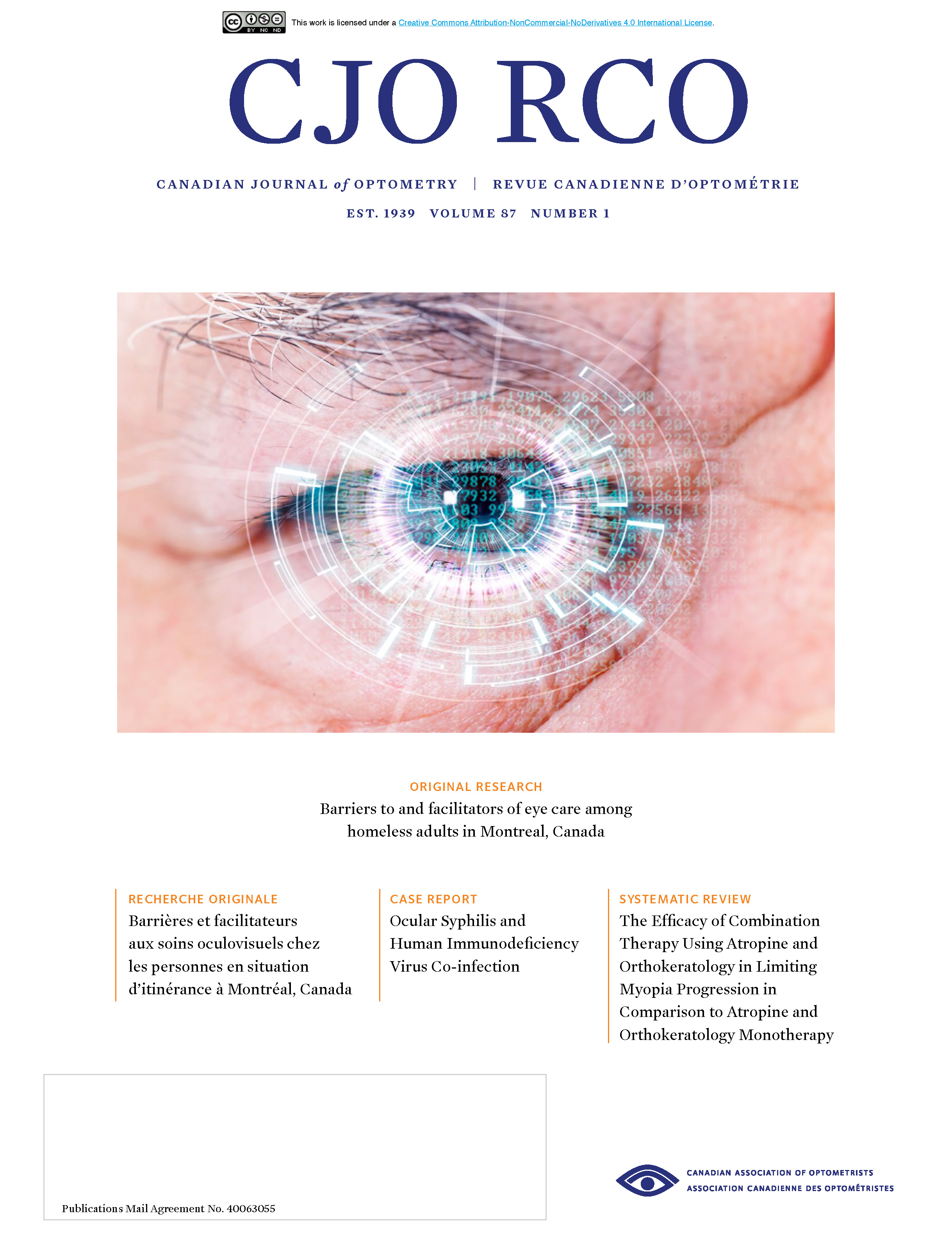Barriers and Facilitators to Eye Care Among Homeless Adults in Montreal, Canada
DOI:
https://doi.org/10.15353/cjo.v87i1.6052Keywords:
Adults, Montreal, Health Services Accessibility, Ill-Housed Persons, Eye CareAbstract
Purpose
People experiencing homelessness have higher prevalence of health and eye problems than the general population and are less likely to access healthcare services, despite universal healthcarecoverage in Canada. This study aims to describe the competing priorities to healthcare and thebarriers and facilitators to eye care for homeless adults in Montreal (Canada), exploring potential differences between genders.
Methods
Cross-sectional study conducted in homeless shelters in Montreal, following stratified randomization. A questionnaire was adapted from existing validated items on competing priorities as well as on barriers and facilitators. Items explored included costs, accessibility and transportation, trust and previous experiences and health literacy. Comparisons were made usingchi-squared and Mann-Whitney U tests.
Results
Six shelters for the homeless were approached and accepted to serve as data collection sites. Sixty-two participants completed the questionnaire and 51.6% (n = 32) identified as women. In all, 69.4% (n = 43) of participants had valid eye care coverage. Half of participants (n = 31) hadnot consulted an optometrist or ophthalmologist in ≥ 3 years. Nearly a quarter (24.2%, n = 15) of participants reported having at least one strongly competing priority. Prohibitive costs were the most strongly identified barrier, with a group median score of 4.0 (IQR 2.0-5.0). Complexity of coverage procedures seemed to be a barrier mostly for men (median score 4.0 [IQR 3.0-5.0] on a 5-point Likert scale). Strong facilitators included trust in optometrists (median 1.0 [IQR 1.0-2.0])and having more than one health and social services in the same location (median 1.0 [IQR 1.0-2.0] on a 5-point Likert scale). No statistical differences were found between men and women.
Conclusion
For adults experiencing homelessness in Montreal, despite large coverage for eye care services, competing priorities and prohibitive costs are strong barriers to seeking care. Trust in optometrists and the grouping of health services are notable facilitators. These data may help develop more inclusive strategies for delivering eye care to this underserved population.
References
1. Ministère de la Santé et des Services sociaux. Dénombrement des personnes en situation d’itinérance visible au Québec. 2024-08-21, Ministère de la Santé et des Services sociaux,. Accessed 2024-08-21, https://publications.msss.gouv.qc.ca/msss/fichiers/2023/23-846-05W.pdf
2. Yelle B, Beaulieu K, Etty M-C, et al. The prevalence and causes of visual impairment among the male homeless population of Montreal, Canada. Clin Exp Optom. 2022:1-5. doi:10.1080/08164622.2022.2036578
3. Noel CW, Srivastava R, Lo R, Berger A, Tehrani N, Lichter M. Unmet eye care needs among a homeless youth population. Can J Ophthalmol. 2016/06/01/ 2016;51(3):180-184. doi:https://doi.org/10.1016/j.jcjo.2016.03.010
4. Park T, Issa M, Mikhail M, et al. Ophthalmic findings in marginally housed women in a Canadian city. Can J Ophthalmol. 2022;59(1):12-18. doi:https://doi.org/10.1016/j.jcjo.2022.11.005
5. Etty MC, Michaelsen S, Yelle B, et al. The sociodemographic characteristics and social determinants of visual impairment in a homeless population in the Montreal area. Can J Public Health. Feb 2023;114(1):113-124. doi:10.17269/s41997-022-00676-y
6. Aljied R, Aubin MJ, Buhrmann R, Sabeti S, Freeman EE. Prevalence and determinants of visual impairment in Canada: cross-sectional data from the Canadian Longitudinal Study on Aging. Can J Ophthalmol. Jun 2018;53(3):291-297. doi:10.1016/j.jcjo.2018.01.027
7. Campbell DJ, O’Neill BG, Gibson K, Thurston WE. Primary healthcare needs and barriers to care among Calgary’s homeless populations. BMC Fam Pract. Oct 13 2015;16:139. doi:10.1186/s12875-015-0361-3
8. Mairs B, Stolee P. An Evidence-Based Guideline for the Frequency of Optometric Eye Examinations. Primary Health Care: Open Access. 2012;02(4)doi:10.4172/2167-1079.1000121
9. Gelberg L, Gallagher TC, Andersen RM, Koegel P. Competing priorities as a barrier to medical care among homeless adults in Los Angeles. Am J Public Health. 1997;87(2):217-220. doi:10.2105/ajph.87.2.217
10. Statistics Canada. Canadian Community Health Survey (CCHS) - 2018. Accessed 2024-08-21, https://www23.statcan.gc.ca/imdb/p3Instr_f.pl?Function=assembleInstr&a=1&&lang=fr&Item_Id=839130#qb839141
11. Indigenous Services Canada. First Nations and Inuit Health Non-Insured Health Benefits Program Vision Care - Fee Grid QC. Updated 2024-11-12. Accessed 2024-12-16, https://nihb-ssna.express-scripts.ca/en/0205140506092019/22/2207
12. Ramsay N, Hossain R, Moore M, Milo M, Brown A. Health care while homeless: barriers, facilitators, and the lived experiences of homeless individuals accessing health care in a Canadian regional municipality. Qual Health Res. 2019;29(13):1839-1849.
13. Mago A, MacEntee MI, Brondani M, Frankish J. Anxiety and anger of homeless people coping with dental care. Community Dent Oral Epidemiol. Jun 2018;46(3):225-230. doi:10.1111/cdoe.12363
14. Ahmed S, Shommu NS, Rumana N, Barron GR, Wicklum S, Turin TC. Barriers to Access of Primary Healthcare by Immigrant Populations in Canada: A Literature Review. J Immigr Minor Health. Dec 2016;18(6):1522-1540. doi:10.1007/s10903-015-0276-z
15. Loignon C, Hudon C, Goulet É, et al. Perceived barriers to healthcare for persons living in poverty in Quebec, Canada: the EQUIhealThY project. Int J Equity Health. Jan 17 2015;14:4. doi:10.1186/s12939-015-0135-5
16. Huang-Lung J, Rai A, Duong A, et al. ‘Whatever the GP says, is what I’ll do’-A qualitative study of patient perspectives in accessing primary eye care for type 2 diabetes. Ophthalmic Physiol Opt. Jan 2025;45(1):67-76. doi:10.1111/opo.13398
17. Hudon C, St-Cyr Tribble D, Bravo G, Hogg W, Lambert M, Poitras M-E. Family physician enabling attitudes: a qualitative study of patient perceptions. BMC Family Practice. 2013/01/10 2013;14(1):8. doi:10.1186/1471-2296-14-8
18. MacKinnon L, Kerman N, Socías ME, Brar R, Bardwell G. Primary care embedded within permanent supportive housing for people who use substances: A qualitative study examining healthcare access in Vancouver, Canada. Health Soc Care Community. Nov 2022;30(6):e5062-e5073. doi:10.1111/hsc.13921
19. Tousignant B. Eye Care for the Homeless First Year of Data from a Mobile Teaching Clinic. presented at: American Academy of Optometry; 2018; San Antonio (TX). Accessed 2024-08-21. https://aaopt.org/past-meeting-abstract-archives/?SortBy=&ArticleType=&ArticleYear=&Title=Eye+Care+for+the+Homeless+First+Year+of+Data+from+a+Mobile+Teaching+Clinic&Abstract=&Authors=&Affiliation=&PROGRAMNUMBER=
Downloads
Published
How to Cite
Issue
Section
License
Copyright (c) 2025 Annabelle Messier, Victoria Barré, Caroline Faucher, Benoit Tousignant

This work is licensed under a Creative Commons Attribution-NonCommercial-NoDerivatives 4.0 International License.


